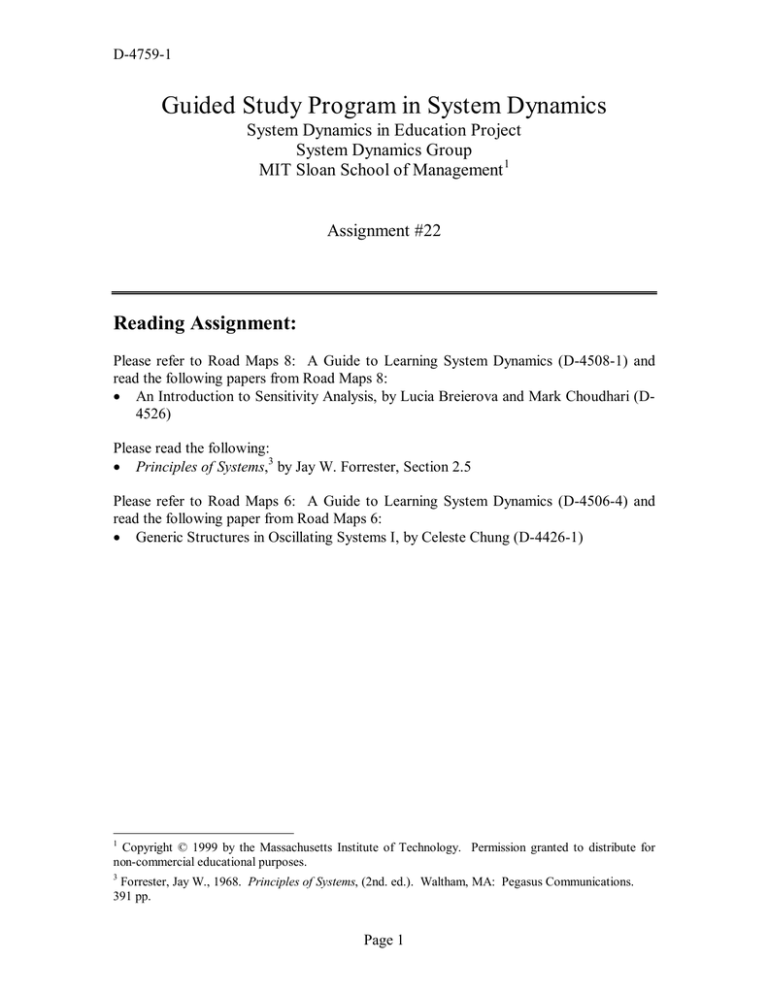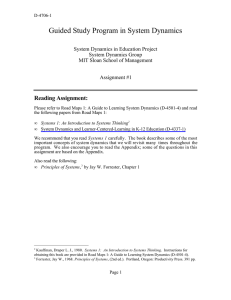Document 13624395
advertisement

D-4759-1 Guided Study Program in System Dynamics System Dynamics in Education Project System Dynamics Group MIT Sloan School of Management1 Assignment #22 Reading Assignment: Please refer to Road Maps 8: A Guide to Learning System Dynamics (D-4508-1) and read the following papers from Road Maps 8: • An Introduction to Sensitivity Analysis, by Lucia Breierova and Mark Choudhari (D­ 4526) Please read the following: • Principles of Systems,3 by Jay W. Forrester, Section 2.5 Please refer to Road Maps 6: A Guide to Learning System Dynamics (D-4506-4) and read the following paper from Road Maps 6: • Generic Structures in Oscillating Systems I, by Celeste Chung (D-4426-1) 1 Copyright © 1999 by the Massachusetts Institute of Technology. Permission granted to distribute for non-commercial educational purposes. 3 Forrester, Jay W., 1968. Principles of Systems, (2nd. ed.). Waltham, MA: Pegasus Communications. 391 pp. Page 1 D-4759-1 Please refer to Road Maps 8: A Guide to Learning System Dynamics (D-4508-1) and read the following papers from Road Maps 8: • Learning Through System Dynamics as Preparation for the 21st Century, by Jay W. Forrester (D-4434) Exercises: 1. An Introduction to Sensitivity Analysis Please build the three models in Vensim PLE and perform all of the sensitivity tests described in this paper. In your assignment solutions document, include the Coffeehouse Model diagram and documented equations,4 and do the following: Find a combination of realistic parameter values that minimizes the oscillations. List the parameter values and justify your choices by arguing that these values are realistic. Demonstrate and explain how this particular combination of parameter values dampens the system. 2. Principles of Systems: Section 2.5: Coupled Nonlinear Feedback Loops This section builds and analyzes the market growth model introduced in assignment 7. As you read this section, please build the model as described in the book. Make sure to non-dimensionalize all of the table functions. You should pay particular attention to choosing appropriate reference or normal values. In your assignment solutions document, please include the model and a graph of the model behavior, as in Figure 2.5d. Work through all of the workbook exercises. 3. Independent Exercise A. Using the methods described in An Introduction to Sensitivity Analysis, perform sensitivity analysis on the market growth model built in Exercise 2. Demonstrate and explain how increases and decreases in each parameter value affect the behavior of the model. B. Find a combination of realistic parameter values that minimizes the oscillations. List the parameter values and justify your choices by arguing that these values are realistic. Demonstrate and explain how this particular combination of parameter values dampens the system. 4 The formulation of the “selling” rate equation as presented in the paper does not show good system dynamics modeling practice. Please use a formulation that does not use a MIN function. Instead, try using a lookup function. Page 2 D-4759-1 4. Learning through System Dynamics as Preparation for the 21st Century: Please read this vision paper and answer the following questions: A. Prof. Forrester listed the objectives of a SD education as developing personal skills, shaping an outlook and personality to fit the 21st century, and understanding the nature of systems in which we work and live. Which objective is most important to you? Has system dynamics helped you meet that objective? B. High leverage policies can often be wrongly applied. Think of an example and explain how the policy could affect the system and what happens if it is wrongly applied. 5. Generic Structures in Oscillating Systems Figure 8 on page 15 shows oscillating behavior of “Employment” and “Inventory.” From your understanding of the model, and from what you have learned through the exercises on oscillating systems, please answer the following questions. A. Build the employment instability model in Vensim PLE. In your assignment solutions document, include the model diagram and documented equations. B. What changes can you make to the model to change the amplitude of the oscillations? Verify your hypotheses by implementing the changes using the model you built in part A. In your assignment solutions document, include graphs of the model behavior that support your hypotheses. C. What changes can you make to the system and model to change the period of the oscillations (the period is the time that passes between two consecutive peaks)? Verify your hypotheses by implementing the changes using the model you built in part A. In your assignment solutions document, include graphs of the model behavior that support your hypotheses. D. Is it possible for “Employment” and “Inventory” to oscillate at different frequencies (the frequency of an oscillation is the inverse of its period)? Why or why not? Page 3


